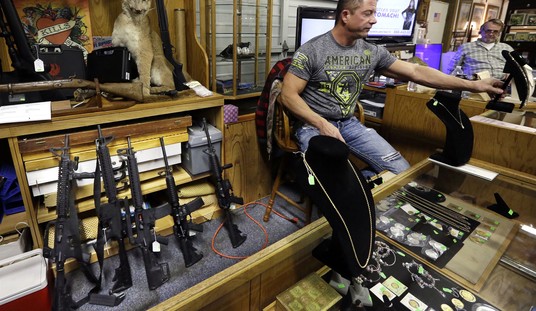Image via Pixabay
Gun control is touted as a solution to so-called gun violence on a daily basis. Entire presidential campaigns have popped up this year centered primarily on this one issue.
Yet we’ve seen in England that getting rid of the guns doesn’t erase the problem. It simply shifts it to another form. Whereas the U.K. was worried about guns, now it has to deal with both that and an increase in knife crimes. So much so that the nation now considers kitchen cutlery as deadly weapons.
It supposedly got rid of the guns, but the violence has remained.
So what can America do? After all, while violent crime rates have been trending downward for decades, no one is going to be satisfied with a violent crime rate above zero. Nor should we. Violent crime is something no society should tolerate, and we don’t.
Where we run into problems is what should we do about it.
I’ve long maintained that the first thing we have to do is get to the roots of violence if we want to combat it. If we figure out the societal triggers for violence and combat those, then we won’t need gun control or knife control or any other laws that restrict the law-abiding citizen. Further, we’ll also be preventing countless deaths, injuries, psychological issues stemming from trauma, and many other ills in this world.
All without infringing on people’s rights.
The problem is, there doesn’t seem to be anyone interested in trying to figure out why people become violent. At least, that’s been my assessment.
It’s probably not a fair one, though.
You see, violence is a complex issue. There’s no one cause for violence in our society. From a 2011 post at Psychology Today:
We used to think that extreme violence took place only in city streets and in countries at war; we now know that violence manifests in churches, schools, rural areas, and small towns. It claims millions of victims all over the world every year. But where does this hostility stem from and how do we make sense out of what are seemingly senseless acts of aggression?
In my 30 years of experience and research, I have identified numerous factors that determine our behavior and whether a person is at risk for developing violent tendencies. These factors include biological traits, family bonding, individual characteristics, intelligence and education, child development, peer relationships, cultural shaping and resiliency.
Each factor of a person’s life or make up can affect and be affected by another factor. When the accumulation of negative factors (such as maltreatment, chaotic neighborhoods, or psychological problems) and the absence of positive factors (such as opportunities to be successful, adults who provide encouragement, or a resilient temperament) reach a threshold, that’s when violence is more likely to erupt as a means of coping with life’s problems.
As such, there probably isn’t any one-size fits all solution to violence.
However, we can look at violence in our communities and see that it can be categorized in various ways, based on a number of factors. After all, it’s not like all violence stems from someone reaching some threshold, right?
For example, we do have studies indicating that cities are more violent than rural areas. That means if we want to combat the murder rates, as well as the rates of other violent crimes, cities are the logical place to target efforts.
Further, we can look at the cities and find a large chunk of homicides are attributed to gang activity. The National Gang Center reports that 13 percent of all murders are gang-related. Combatting gangs would prevent somewhere in the neighborhood of 2,000 murders each year.
Additionally, gangs account for a large number of non-fatal violent crimes in American cities as well.
Combatting gangs would go a long way toward preventing violence in this country.
Of course, this is easier said than done. Efforts to combat gang violence have been going on for decades, with varying degrees of effectiveness, but most seem to focus on giving people an alternative to the gang lifestyle.
The LAPD reports that people join gangs for one or more of five potential reasons:
- Identity or recognition
- Protection
- Fellowship or Brotherhood
- Due to Intimidation
- Criminal Activity
Anti-gang efforts often include activities that are meant to provide some of these in an alternative format. There’s not much a church group can do to help someone who wants to engage in criminal activity, but they can provide alternatives to those seeking fellowship with others or a sense of identity.
And these programs have probably helped a good bit.
You see, when we start trying to prevent violence at the roots rather than creating laws dealing with the weapons themselves, things get murky. It’s difficult to tell when something is working. We don’t get to hear stories about arrests or read about ATF raids of black market warehouses that tell us someone is doing something.
Instead, we just don’t.
People don’t get shot. They don’t get killed. They continue with their lives, oblivious to the fact that their life was at risk and are just as oblivious to the fact that it was saved.
Additionally, the would-be perpetrator turns into a contributing member of society. Yet another life saved by intervention.
The problem is that while gangs account for a sizeable portion of the violent crime in our nation, they don’t account for all of it. There’s still a lot more out there, and while it’s easy to look at gangs and blame all of the problems on them, that would be lazy to an extreme.
If only we could stop bickering about the tools these people use and start talking about the people themselves, trying to figure out how to prevent them from becoming violent offenders in the first place, we might save even more lives.








Join the conversation as a VIP Member